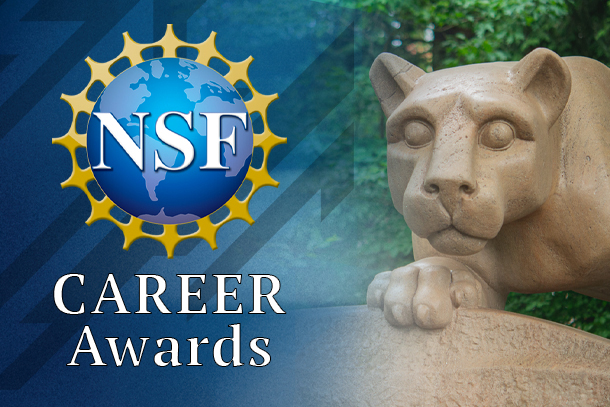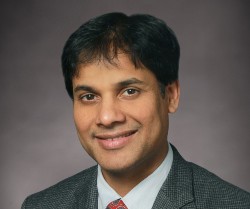
Credit: Kate Myers/Penn State
2023 NSF CAREER Award: Sri-Rajasekhar Kothapalli
March 24, 2023
UNIVERSITY PARK, Pa. — Sri-Rajasekhar "Raj" Kothapalli, assistant professor of biomedical engineering, earned a five year, $528,667 NSF CAREER Award for a project titled “Smart and scalable approaches for developing multimodal optical and acoustic imaging technologies.”
What do you want to understand or solve through this project?
Studying the complex and dynamic mechanisms of a disease, such as brain cancer, in a living subject is crucial for developing reliable diagnostic and therapeutic strategies. The main research goal of this project is to develop a new transparent ultrasound transducer technology that integrates optical, ultrasound and photoacoustic imaging to provide comprehensive information on the structural, functional and molecular biomarkers of deep brain tissue with high spatial and temporal resolutions in real time. The project aims to address long-standing challenges of multimodal brain imaging, such as heterogeneous acoustic wave scattering by the skull bone, by developing accompanying imaging simulations and artificial intelligence tools. The ultimate objective is to gain novel insights into the mechanisms of brain cancer and its effects on neural activity and vice versa.
How will advances in this area impact society?
The fundamental studies on the effects of brain cancer on neural activity can help identify new therapeutic methods for treating lethal brain cancers. Additionally, the proposed multimodal imaging technology has the potential to be applied in clinical settings, such as image-guided cancer biopsy, providing complementary diagnostic information in a single procedure, which can reduce discomfort to patients and decrease healthcare costs. Furthermore, the proposed technology can be used in life science research to study the mechanisms of ultrasound and light modulation of cells or tissue using multimodal imaging. Overall, the advances in this project can have a far-reaching impact on the biomedical and life science communities by making these tools more accessible to researchers engaged in diverse applications.
Will undergraduate or graduate students contribute to this research? How?
Yes, both undergraduate and graduate students will have the opportunity to contribute to this multidisciplinary research project. They will receive hands-on training in various fields such as material science, ultrasound, optics, photoacoustics, computational imaging and modeling, artificial intelligence, cancer and neuroscience research. The students will be able to contribute to the project by conducting research, analyzing data and collaborating with the research team. Additionally, they will be trained to take on leadership roles in organizing workshops and outreach activities, which will help disseminate the project's findings to the broader scientific community and the public.
The NSF CAREER award not only funds a research project, but it also recognizes the potential of the recipient as a researcher, educator and leader in their field. How do you hope to fulfill that potential?
I consider myself fortunate to have received extensive education and research training in developing innovative biodevices from scratch and, more importantly, translating them for use in both pre-clinical and clinical applications. Leveraging this background, I hope to inspire and mentor the next generation of scientists and engineers, particularly those from underrepresented groups, in developing affordable biodevices capable of reliable imaging, sensing and actuation. Through workshops and outreach activities, I will share my knowledge and enthusiasm for science and engineering with K-12 students, teachers and the broader community, promoting interest in STEM fields and encouraging young people to pursue careers in these areas. Some planned outreach educational activities include the fabrication of an inexpensive ultrasound bioreactor for cell stimulation; a live demonstration of smart and portable ultrasound imaging; and developing new teaching materials at the intersection of multimodal biosensing and artificial intelligence. Finally, I hope to collaborate with fellow researchers and industry partners to advance the development and application of smart biomedical imaging and sensing technologies and to contribute to the growth of the field and make a meaningful impact.




